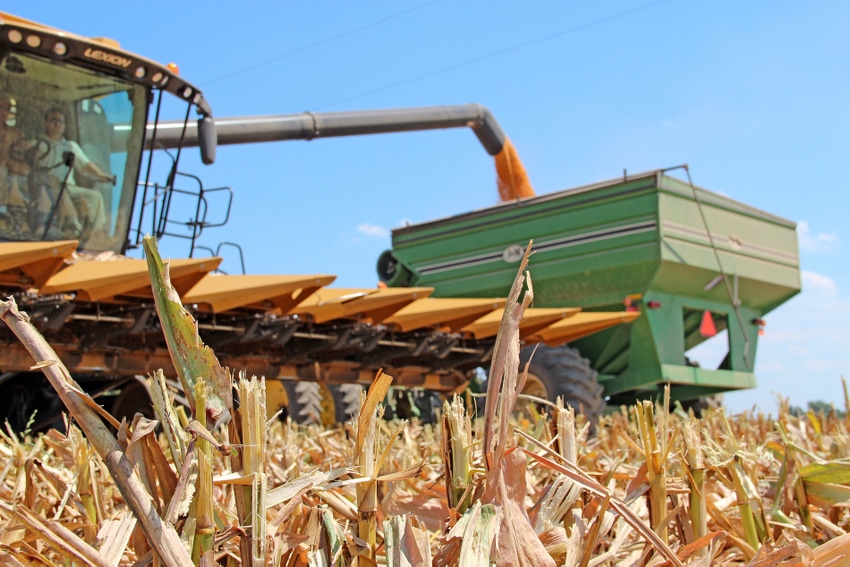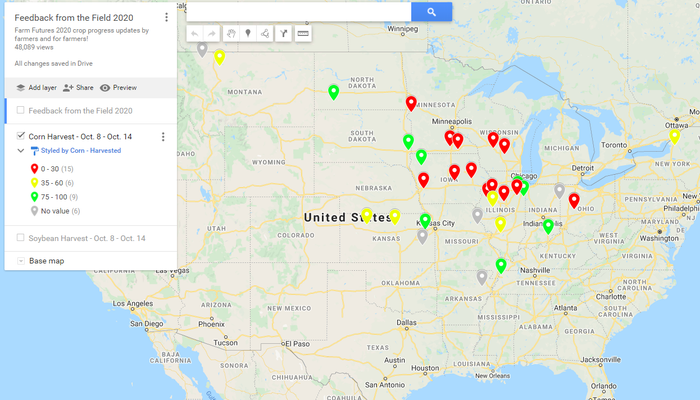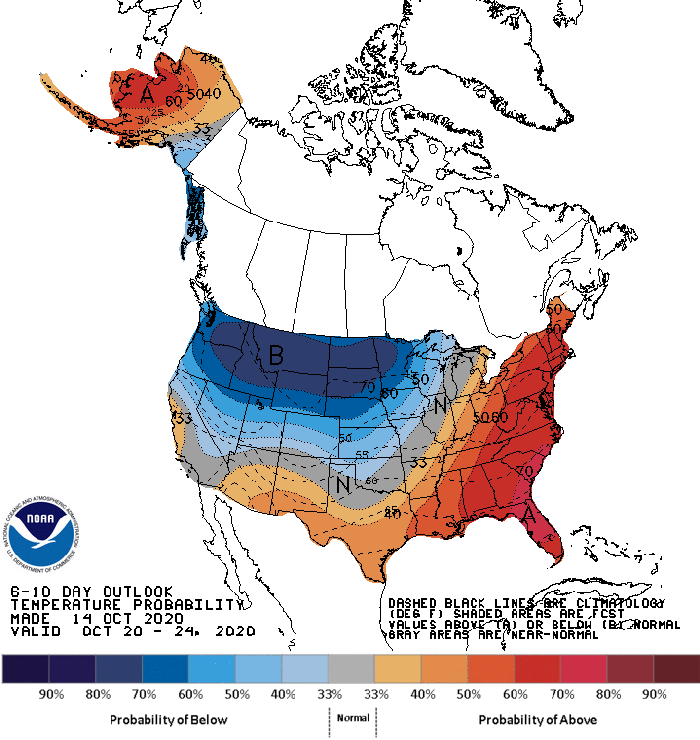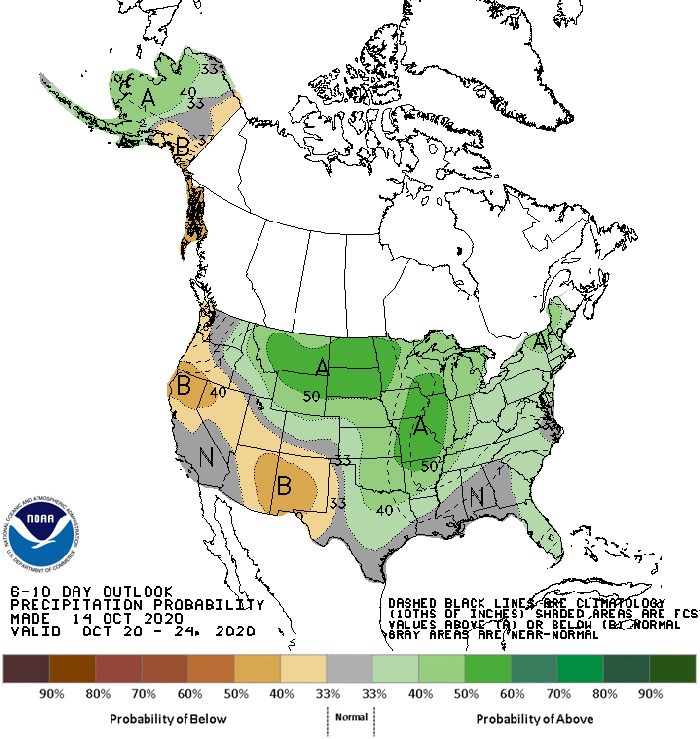
Want to see your harvest progress stacks up against other growers in the country? Click here to share your crop updates via a short survey. The map is updated daily to showcase harvest progress across the country. Thank you!
With virtually all of the 2020 corn crop matured, corn harvest progress is picking up momentum across the U.S. Yesterday’s Crop Progress report found 94% of corn matured, up 7% from the previous week and well ahead of the five-year average of 87%.
But corn crops have been slow to mature in many areas. “Corn is not drying down,” an Ohio corn grower lamented while awaiting a start to harvest.
As of October 11, 41% of the nation’s corn crop was harvested. The total surprised market analysts, who had predicted the weekly progress to reach 39%.

A week of above average temperatures and clear skies sent harvesting rates 16% higher than the previous week’s Crop Progress report. Harvesting paces pulled away from the five-year average this week by the widest margin all harvest season. As of last Sunday, corn harvesting progress was 9% higher than the five-year benchmark.
Corn conditions deteriorated slightly last week as the crop continued to dry down. For the week ending October 11, ratings fell 1% from the previous week to 61% good to excellent.
Strong wind gusts in Kansas threatened unharvested crops on Sunday afternoon. Winds clocking in at “70 mph blew some ears off and laid over some corn,” a Kanas Farm Futures reader reported.
A Southern Indiana grower observed below trendline yields as harvest in the area ended. “[Yields are] averaging 152 bpa and harvested at 21% moisture,” the farmer said. “Dry July [weather] and later rains didn’t fully restore the yield potential.”
“Great test weights,” a New York corn grower commented.
Good, not great
The U.S. soybean crop reach its final stages of maturity last week due in large part to warm and dry weather. As of October 11, 93% of the crop was dropping leaves, up 8% from the previous week and 3% ahead of the five-year average.
Dry weather continues to plague growers with an Iowa farmer noting, “no rain in July and August. Less than four inches since planting.” An Ohio farmers observed yields that were “down 20 bpa from last year,” due largely to the lack of rainfall in the past couple months.
The favorable fall weather allowed soy growers to advance harvest paces 23% from the previous week to 61% complete as of last Sunday. The total was 19% higher than the five-year average. Trade predictions had pegged the weekly estimate lower at 59%. At that rate, soybean harvest will likely come to a close in the next four weeks if dry weather continues across the country.
Similar to corn, the dry weather led to a drop in soybean quality last week. For the week ending October 11, soybean condition ratings fell 1% to 63% good to excellent.
Yield estimates continue to be average at best, as described by one Illinois grower. “Only one field made APH average. But none were low enough to trigger insurance and none high enough to brag about. Yield range 50 to 62 bpa.”
“A very dry September affected the seed size reducing the overall crop yield,” projected a Southern Indiana grower.
“No record setting, but better than expected,” a Western Illinois farmer conceded. A South Dakota grower echoed the sentiment, noting yields were “Better than expected for a dry August.”
“92% of 5-year average, down 6.5 bpa from last year,” shared an Iowa grower.
“Finished at 68 bpa. Probably left a few bushel in the field due to lodging and shattering. Dried in a hurry this week,” a Wisconsin reader mused.
Moisture badly needed
Despite dry weather across the Midwest and Plains, U.S. wheat growers plowed ahead with planting the winter wheat crop. As of October 11, 68% of anticipated winter wheat acreage was planted. It was a 16% increase from the previous week and was 7% ahead of the five-year average. Fast corn and soybean harvests in the Midwest also enabled a rapid planting rate.
Dryness in the High Plains held emergence rates below the five-year average for the newly planted winter wheat crop. But favorable emergence progress in the Midwest and Kansas sent the weekly emergence rate to 41%. The total was a 17% increase from the previous week and 6% higher than the five-year average.
“[Wheat] wont’ emerge without rain,” one Kansas farmer lamented. Another Kansas grower echoed the concern, noting “bone dry conditions. I’m shocked that any wheat has come up,” the grower confessed. “Half of it needs a good rain before it grows.”
Growers on the Plains aren’t the only ones feeling the pain of record-setting drought conditions.
“All [the] seed is sitting in dust,” the grower shared.
Rain showers in sight
Temperatures are expected to cool next week across the Plains, with a 40% - 80% likelihood of below average pressures during the early half of next week according to NOAA’s 6 to 10-day forecast. Those conditions will likely continue into the weekend. Temperatures in the Eastern Corn Belt and South are more likely to be higher than average across the same time period.

Favorable harvest conditions will likely be interrupted in next week’s forecast. The 6 to 10-day outlook Shows about 33% - 50% probability of above average precipitation accumulation in the Plains and Corn Belt.
While the showers would slow a rapid harvest progress rate, the dry soil conditions would welcome any sort of substantial accumulation. And any potential harvest delays would be short-lived. By the end of the week, above average chances for rain across the Midwest and Plains slips to 33% - 40%.

Follow along with the season:
Feedback from the Field: Week Ending October 4, 2020 - Soybean harvest surges ahead amid variable yield reports.
Feedback from the Field Roundup: Week Ending September 20, 2020 - Corn conditions improve as harvest ramps up
Feedback from the Field Roundup: Week Ending September 13, 2020 - Harvest in sight across the Midwest and Plains.
Feedback from the Field: Week Ending September 6, 2020 - Soybeans cave to heat stress and low soil moisture
Feedback from the Field Roundup - Week ending August 30 - Corn, soybean ratings continue to slide lower.
Feedback from the Field Roundup – Week ending Aug. 23, 2020 - A closer look at derecho crop damage sends corn ratings tumbling.
Feedback from the Field Roundup: Week Ending August 9, 2020 - Dry conditions expected to be exacerbated by yesterday’s derecho winds.
Feedback from the Field Roundup: Week ending August 2, 2020 - Wheat harvest rolls on in the Northern U.S.
Feedback from the Field Roundup – Week ending July 26, 2020 - Improved corn conditions offset drought, wind damage.
Feedback from the Field – Week ending July 19, 2020 - Crops withstand the heat while pastures and rangeland suffer lowest ratings since 2012.
Feedback from the Field: July 7, 2020 - Crops stand up to hot weather – for now.
Feedback from the Field: June 30, 2020 - Despite strong ratings, the corn crop may face challenges during silking process.
Feedback From The Field: June 23, 2020 - Readers report solid corn and soybean crop quality so far this year.
About the Author(s)
You May Also Like






